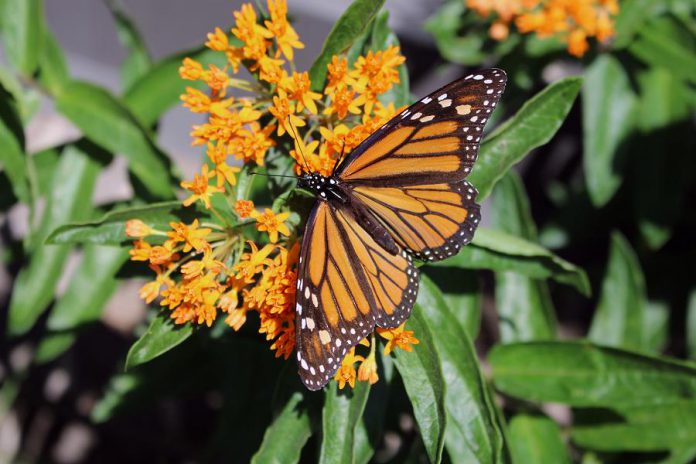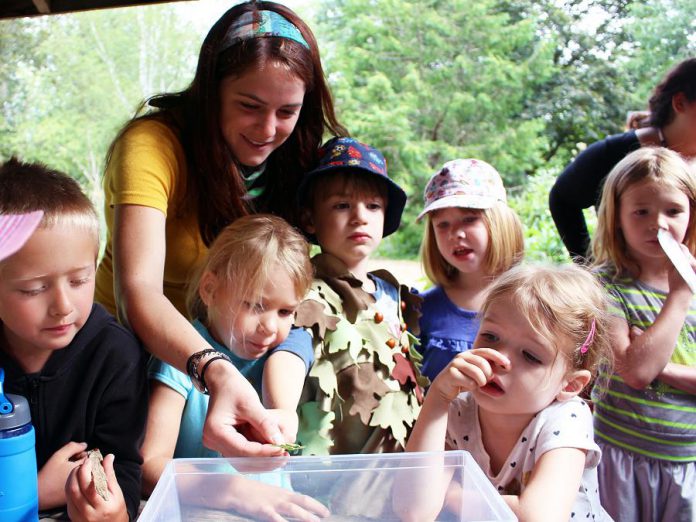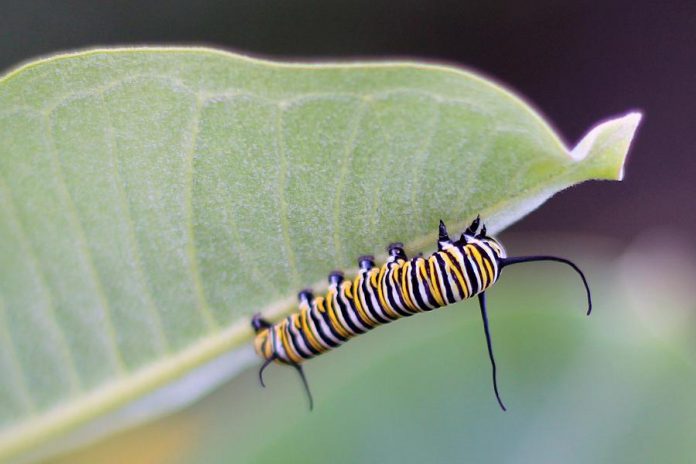
GreenUP is always excited to celebrate this special time of year, when monarch butterflies visit our gardens to sample the abundant nectar from flowers and search for a very specific plant to lay their eggs upon a once-common plant — milkweed.
Milkweed is the host plant for monarchs. When a monarch larva (or caterpillar) emerges, it feeds exclusively on milkweed until its metamorphosis occurs.
But let’s back up the story a bit. Monarch butterflies begin their life as an egg laid on the underside of a milkweed leaf. Three to five days later, the egg hatches and a caterpillar emerges.
The caterpillar stage starts when it eats the eggshell it has emerged from and then moves on to the milkweed plant on which the egg was laid. In this larval stage, the monarch does most of its growing.

The caterpillar can grow up to 2,000 times its original size, molting and shedding skin several times as it expands. The intervals between molts are called instars, of which monarch caterpillars go through five.
A caterpillar spends its time gorging on milkweed and, after the eating is done, finds a suitable location where it won’t be disturbed so the transformation into a butterfly can begin.
After shedding its black, yellow, and white-striped skin, a lime green creature (pupae) emerges, which quickly hardens and transforms into a chrysalis. The chrysalis hangs from a silk pad spun by the caterpillar.
The chrysalis stage lasts between nine and 14 days. When it is time for the adult butterfly to emerge, it slowly wiggles free from the chrysalis and pumps fluid from its body into to the wings. The butterfly clings to its former home, allowing its wings to dry and stretch out before finally taking flight in search of nectar-rich flowers.

The primary job of the adult monarch is to mate and lay eggs that will become the next generation of butterflies. Females begin laying eggs right after their first mating, and both sexes will mate several times during their lives. There are typically four generations of monarchs over the course of a breeding season.
The eggs that we see now, attached to the underside of milkweed plants, are the final generation of the year that will emerge as adults later this month and into September. They will be faced with the daunting task of migrating south to overwintering grounds in central Mexico.
There, they will cluster together, suspended in trees, waiting out the long winter happening back in the north. Sadly, many won’t safely make it there and back.
Monarchs are vanishing at an alarming rate. According to Monarch Watch, since March 2013 the North American population of monarch butterflies has declined by 59 per cent — the lowest recorded population status since 1975.

How can we explain such a sharp decline in monarchs?
Unstable weather patterns, which bring harsh storms and erratic temperatures, are contributing factors to this decline. Last summer, while GreenUP staff conducted annual egg counts, only two eggs were found among a field of dry and browned milkweed that was parched due to the extreme drought conditions that we experienced. No caterpillars were found last year.
This year seems to be a more productive year for monarchs in the Peterborough area with many adults, eggs, and caterpillars being observed at both the GreenUP Store gardens, and at Ecology Park. Unfortunately though, the estimates for monarch populations are still down.
Another important factor in the decline of the monarch is the availability and distribution of milkweed throughout the habitat range. Monarchs depend solely on milkweed as a host plant for both food and breeding and its growth is crucial for the survival of monarchs.

In recent years, we’ve witnessed a decline in milkweed. This is especially true in North America where, historically, the plant has been eradicated with herbicides in rural areas.
Until only three years ago, milkweed was considered a nuisance plant, especially to farmers. The abundant seed heads germinate and grow into large plants that take over production fields.
But thanks to researchers and citizen scientists throughout North America, we have begun to appreciate the relationship between milkweed and monarch butterfly populations and now encourage milkweed to be planted or left where it grows.
Swamp, butterfly, and common milkweed are three varieties that grow in the Peterborough region. GreenUP Ecology Park Garden Market sells all three varieties, along with a variety of native nectar-rich Ontario plants adult butterflies love. GreenUP Ecology Park Garden Market is open at 1899 Ashburnham Drive on Thursdays from noon to 6 p.m. and Saturdays and Sundays from 10 a.m. to 4 p.m.
You can also refer to the online plant catalogue at www.greenup.on.ca for a full list of available native plants, trees, and shrubs.



























